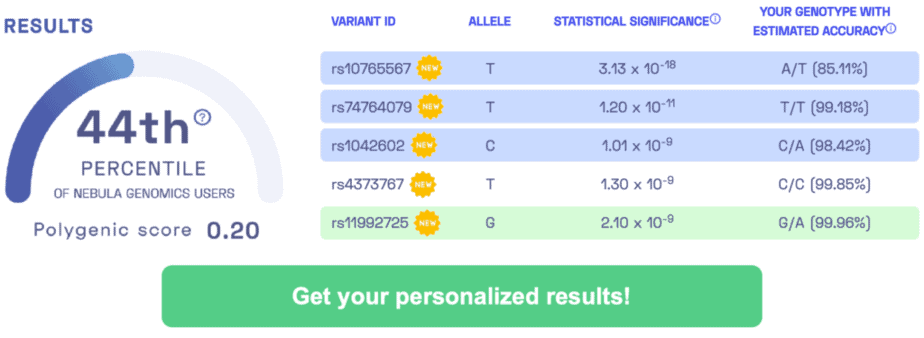Lifespan Report in the Nebula Library
STUDY TITLE: Multivariate genomic scan implicates novel loci and haem metabolism in human ageing (parental lifespan)
SUMMARY: Identification of 10 genetic variants linked to parental lifespan.
OVERVIEW: Worldwide, the average lifespan is 70 years for males and 72 years for females. Many people, though, live well into their 90s or 100s. Though factors such as diet and access to health care influence how long an individual may live, genetics also plays a role. Overall, genetics may account for between 10-30% of the variation in lifespan. As a result, examining the lifespans of an individual’s parents may help predict the offspring’s expected lifespan. This study examined the genomes of over 1 million individuals of European ancestry to identify variants associated with parental lifespan. The study discovered 10 genetic variants that are linked to parental lifespan, but also associated with an individual’s healthspan and longevity. Multiple variants are in genes that have been previously connected to aging and metabolism. For example, a variant in the APOE gene (rs429358) can on average increase a parent’s lifespan by over 2 years.
DID YOU KNOW? While parents have an influence on their children’s lifespan through the genes that they pass down, it seems that children may have an effect on their parents’ lifespan as well. A study found that people with children often live longer than those without children. Even adopted children appear to impart this effect, potentially adding up to 3 years to the lifespan of their adoptive parents. [SOURCE]
SAMPLE RESULTS: Learn more about the Nebula Research Library.

PARENTAL LIFESPAN-ASSOCIATED VARIANTS: rs429358, rs10455872, rs7859727, rs61905747, rs6511720, rs12830425, rs1159806, rs4783780, rs2643826, rs17499404
ADDITIONAL RESOURCES:
The science of aging (Video)
Is longevity determined by genetics?
YOU MAY ALSO BE INTERESTED IN:
Longevity (Deelen, 2019)
WEEKLY UPDATE: July 28, 2020
More about Human Lifespan
Life expectancy is the average time a living being is expected to live from a given point in time until death. This should not be confused with lifespan, which refers to the maximum amount of time someone can live.
Calculating life expectancy
Life expectancy is calculated based on observed mortality rates in the past along with model assumptions for future mortality rates. The mortality tables give this information through the exact number of survivors and deaths per 100,000 inhabitants of previous years.
In principle, we can choose any point in time from which the remaining life expectancy is calculated. Most often, life expectancy at birth is of interest in public health.
Comparison with people born in the same year results in cohort life expectancy. If we assume that different ages have different mortality rates, the resulting life expectancy might be different. This is called period life expectancy.
In many cases, it is not the total population of newborn babies that is considered, but a certain group. This group can be categorized through residence or age. Information on the statistical dispersion of life expectancy is hence of interest here.
Life expectancy is an important indicator for social and economic status. The higher it is for a particular group, the higher its standard of living. In 2019, the highest life expectancy was found for Japan with around 84.6 years according to Our World in Data. The average life expectancy of people in the United States is quite high, around 78.9 years.
Life expectancy is often classified according to gender, nation of origin, occupation or specially identified risk group. Difference according to certain groups is of interest in the insurance industry to calculate risks and to assess premiums or pensions.
What determines human lifespan?
Human life expectancy is determined by a wide range of influencing factors, especially age at the time of calculation. Provided that populations are not decimated by major disasters, factors such as cell ageing play important roles in determining life expectancy. Under good conditions, human life spans age 100 and older. The longest lived person to date (Jeanne Calment) reached an age of 122 years.
The maximum human lifespan has been subject to discussion among researchers for many years. While some believe that human lifespan may be unlimited, many are convinced of a natural limit to humans’ maximum lifespan. A study using life tables from 1950-2005, for example, found that the maximum human lifespan is around 126 years.
Increased life expectancy is nevertheless accompanied by worse health conditions of the long lived elders. The years of life with serious illness rise as people can live long enough to experience ageing. The amount of DNA damage over the course of a person’s life is likely the cause.
By adopting a healthy lifestyle, this process can be slowed down but ultimately cannot be stopped. If cell damage exceeds a certain threshold, the death of the individual is inevitable. This is true even if no disease that would inevitably lead to death, such as a malignant cancer, was previously present.
What affects average lifespan?
Factors such as genetic makeup, lack of hygiene, inadequate nutrition, stress, and lack of medica, can limit life expectancy. This was true before the industrial era and still applies to many developing countries.
Where those conditions are at an acceptable level, the following key factors, among others, are considered significant:
- High blood pressure
- Smoking and excessive alcohol consumption
- Obesity
- Diabetes or high blood sugar level
- Lack of exercise
- High cholesterol level
Those factors are also age specific, significantly more risky in older people than in younger people. Infectious diseases during childhood also affect life expectancy.
Biological differences due to different chromosome sets may also affect average life expectancy. Two copies of X chromosome means that genetic defects that are located on a single X chromosome can be read off. Such unguarded X chromosomes are also likely responsible for reduced lifespan in various animal species. Two X chromosomes may also represent immune genes of both parents.
The abundance of certain hormones can also affect general wellness that leads to humans reaching older age at death. Too much testosterone in blood, usually from testosterone therapy abuse, can increase the risk of heart disease. Too many estrogens could also induce an aggressive immune system and decrease one’s lifespan.
Social status and life expectancy
Factors related to social status can also affect the average number of years a human expected to live. Different lifestyles sought as a consequence of social construct, for example, can affect average life expectancy in men and women differently. Religion is likely to promote healthy lifestyles as people with religion tend to live longer than people without.
Social support may increase average life expectancy in people who were involved in a social system. For example, married people have higher life expectancy than single or widowed people. A study on Swedish couples in 2016 also found lower death risks in people with children compared to childless people.
Difference in social norms and role behavior between men and women also contribute to gender difference in life expectancy. A study of 141 countries between 1981 and 2002 showed that gender influences the death rate from natural disasters. The breakdown of order leaves women more exposed to domestic and sexual violence.
A study from 2005 found that the extent of a society’s patriarchal orientation is related to the life expectancy of men. The researchers argue that patriarchy harms men even though it grants them certain advantages.
Social status can indirectly affect health and life expectancy through material and psychosocial resources and burdens as well as health behaviour. The opportunities for a healthy and long life are already laid down early in life, sometimes due to family history. It becomes more firmly established in the course of life through interactions between social status and health status. In the United States, there is a correlation between people’s life expectancy and educational attainment, occupation or income.
Life expectancy of other living beings
Life expectancy of other living beings also depends on many factors. Other than the species’ own quirks, many environmental variables also influence their lifespan e.g. diseases, predators, temperature, oxygen turnover, and basal metabolic rate.
Examples of special short lifespan
Single-celled organisms such as bacterias reproduce by cell division, which can be regarded as an extremely short life span. Some species of abdominal harriers live only about three days and are therefore among the most short-lived multicellular organisms.
Mayflies can live for several years in total with only a few hours spent as an adult. They are not even capable of feeding at this stage and do not have functioning mouth parts.
Examples of special longevity
The longevity of elephants, turtles, parrots and pine trees is widely documented. Glacial sharks can live for over 400 years. Sequoias were felled, for which an age of about 2000 years was determined by means of annual rings. Specimens of the long-lived pine tree are known to be over 5000 years old.
The glass sponge Anoxycalyx joubini, a giant Antarctic sponge, have a maximum lifespan of 10,000 years. Another glass sponge that had fossilized in the East China Sea, Monorhaphis chuni, may have lived for around 11,000 ± 3,000 years.
Bacteria can survive for several millennia in the form of spores. Thus, marine bacteria in a form capable of reproduction were extracted from salt deposits. Spores fossilised in amber may contain hundreds of bacteria that have lived for 25 to 40 million years.
Organisms that grow apart through budding such as fungi and freshwater polyps seem to be immortal in principle. Nonetheless, there is a change with each budding event and thus a new beginning for an individual.
Human influence
Animals in captivity often reach a much higher age than in the wild. They were protected from predators, extreme weather conditions and food shortages. Animals kept for slaughter, however, have a much lower lifespan due to the system.
